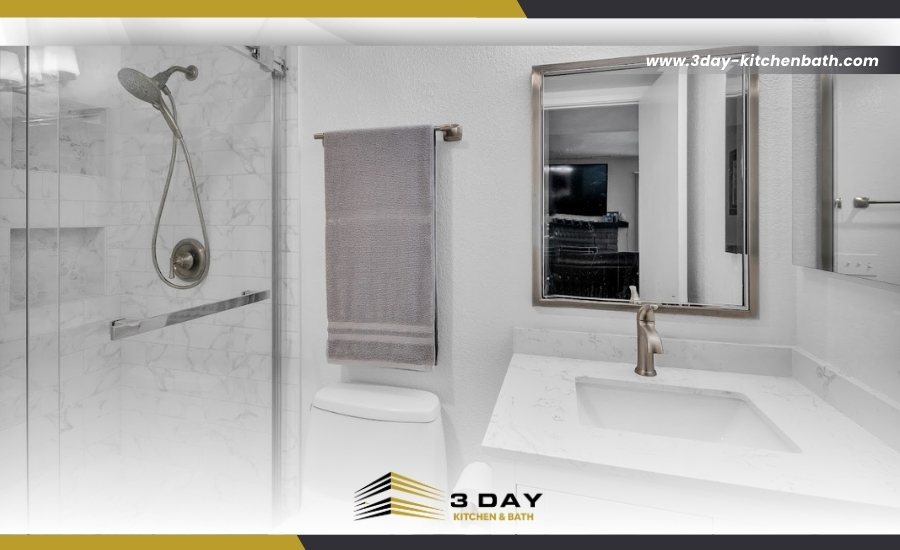Renovating and remodeling are two popular ways to update a home. Understanding the difference between these two options is crucial for making the right decision for your home improvement project. This guide will help you compare renovation and remodel, and understand the costs, timeframes, design considerations, and much more for whole home remodeling.
- What is the Difference Between Renovation and Remodel
- Definition of Renovation
- Definition of Remodel
- Key Differences and Importance
- Cost Comparison of Renovation vs Remodel
- Typical Costs of Renovation Projects
- Typical Costs of Remodeling Projects
- Hidden Costs and Financial Incentives
- Timeframe for Renovation and Remodel Projects
- Average Duration for Renovation
- Average Duration for Remodeling
- Impact on Daily Life and Business Operations
- Design and Aesthetic Considerations
- Flexibility in New Builds
- Limitations in Renovations
- Achieving Unique Aesthetics in Renovations
- Impact on Home Value
- High ROI Renovation Projects
- High ROI Remodeling Projects
- Long-term Value Considerations
- Environmental and Community Benefits
- Sustainability in Renovations
- Community Benefits of Refurbishing
- Financial Incentives for Eco-Friendly Projects
- Regulatory and Structural Considerations
- Understanding Building Codes
- Ensuring Structural Integrity
- Navigating Historical Preservation
- Pros and Cons of Renovation vs Remodel
- Pros and Cons of Renovation
- Pros and Cons of Remodeling
- Real-life Examples and Case Studies
- Personal and Situational Factors
- Deciding Based on Personal Needs
- Factors to Consider: Location and Budget
- When to Choose Renovation or Remodeling
- Expert Tips for Successful Projects
- Planning and Budgeting Tips
- Tips for a Successful Renovation
- Tips for a Successful Remodeling Project
- Making the Right Home Improvement Decision
- Frequently Asked Questions
- What are the biggest challenges in renovation?
- How do I choose between renovation and remodeling?
- What permits do I need for a renovation project?
- How can I budget effectively for a remodel?
- How do renovations impact home resale value?
- Contact 3 Day Kitchen & Bath in San Diego, CA
What is the Difference Between Renovation and Remodel
Understanding the distinction between renovation and remodel can help you choose the right approach for your home improvement needs.
Definition of Renovation
Renovation involves updating or restoring parts of a home without making major structural changes. This can include repainting, refacing cabinets, or installing new fixtures. Renovations aim to refresh and modernize spaces while maintaining the existing layout.
Definition of Remodel
Remodeling, on the other hand, involves changing the structure or layout of a home. This can include knocking down walls to create an open floor plan, adding an extension, or converting a garage into a living space. Remodels aim to alter the function and design of a space significantly.
Key Differences and Importance
The key difference between renovation and remodel lies in the scope and impact of the changes. Renovations are usually less invasive and less expensive, while remodels involve more complex alterations and higher costs. Knowing these differences helps you plan your project according to your needs and budget.
Cost Comparison of Renovation vs Remodel
When deciding between renovation and remodel, cost is a major factor. Understanding the typical expenses involved can help you budget effectively.

Typical Costs of Renovation Projects
Renovations generally cost less than remodels. Common renovation projects include updating a bathroom or kitchen, repainting, or installing new flooring. These projects can range from a few hundred to several thousand dollars, depending on the scale and materials used.
Typical Costs of Remodeling Projects
Remodeling projects tend to be more expensive due to the structural changes involved. Examples include adding a room, changing the layout of a kitchen, or converting a basement into a living area. Remodeling costs can range from several thousand to tens of thousands of dollars, depending on the complexity and materials.
Hidden Costs and Financial Incentives
Both renovation and remodeling projects can come with hidden costs. Unexpected issues like outdated wiring, plumbing problems, or structural damage can increase expenses. However, financial incentives such as tax credits or grants for energy-efficient upgrades can help offset some costs.
Timeframe for Renovation and Remodel Projects
The duration of a project is another important factor to consider. Understanding how long renovations and remodels typically take can help you plan your project timeline.
Average Duration for Renovation
Renovation projects usually take less time than remodels. A simple renovation like repainting a room or updating fixtures can take a few days to a few weeks. More extensive renovations, such as a kitchen update, might take a few weeks to a couple of months.
Average Duration for Remodeling
Remodeling projects often require more time due to the structural changes involved. Adding a room or converting a space can take several months. Larger remodels, like a full home makeover, can take six months to a year or more.
Impact on Daily Life and Business Operations
Both renovations and remodels can disrupt daily life. Renovations might require you to temporarily move furniture or avoid certain areas. Remodels, especially large ones, might require you to move out of your home temporarily. Planning can help minimize disruptions.
Design and Aesthetic Considerations
Design and aesthetics play a significant role in any home improvement project. Whether you are renovating or remodeling, understanding the design possibilities and limitations is essential to achieving your desired look and functionality.

Flexibility in New Builds
When building new, you have complete control over the design and layout of your home. This flexibility allows you to customize every aspect to suit your preferences and needs. From choosing the architectural style to deciding on the floor plan, new builds offer the freedom to create a home that reflects your taste and lifestyle.
Limitations in Renovations
Renovations often come with certain constraints due to the existing structure. While you can make many updates, some elements may limit what you can achieve:
- Structural constraints: You might be unable to move load-bearing walls.
- Design restrictions: The existing layout may not allow for significant changes.
- Historical preservation: If renovating an older home, you might face restrictions to maintain its historical integrity.
Achieving Unique Aesthetics in Renovations
Despite limitations, renovations can still result in unique and appealing designs. Here are some ways to enhance aesthetics in renovations:
- Retain and highlight original features like exposed brick or wood beams.
- Use modern materials and fixtures to update the space while keeping its character.
- Integrate energy-efficient solutions to blend style with sustainability.
Impact on Home Value
Both renovation and remodeling projects can significantly impact the value of your home. Understanding which projects offer the best return on investment (ROI) can help you make informed decisions and maximize your home's market potential.

High ROI Renovation Projects
Certain renovation projects are known for their high ROI. These projects not only enhance your living space but also increase the overall value of your home. Some examples include:
- Kitchen updates: Modernizing a kitchen with new countertops, cabinets, and appliances.
- Bathroom renovations: Upgrading fixtures, and tiles, and adding energy-efficient features.
- Curb appeal enhancements: Improving the exterior with landscaping, new paint, and updated entryways.
High ROI Remodeling Projects
Remodeling projects can also offer substantial returns, especially when they involve major improvements or additions. High ROI remodeling projects include:
- Room additions: Adding extra bedrooms or bathrooms to increase living space.
- Basement conversions: Transforming an unfinished basement into a functional living area.
- Open floor plans: Creating an open layout to improve flow and usability.
Long-term Value Considerations
When planning your renovation or remodel, consider the long-term value and appeal of the changes. Projects that improve energy efficiency, functionality, and aesthetic appeal tend to have lasting benefits. Additionally, choosing timeless designs over trendy ones can help maintain your home's value over time.
Environmental and Community Benefits
Renovation and remodeling projects can also have positive impacts on the environment and the community. By making eco-friendly choices and revitalizing existing structures, you contribute to sustainability and local development.
Sustainability in Renovations
Renovations offer opportunities to improve your home's environmental footprint. Consider incorporating sustainable practices such as:
- Energy-efficient upgrades: Installing energy-efficient windows, insulation, and HVAC systems.
- Using recycled materials: Opting for recycled or reclaimed materials for floors, countertops, and fixtures.
- Water-saving fixtures: Installing low-flow toilets, faucets, and showerheads.
Community Benefits of Refurbishing
Revitalizing existing structures can benefit the community in several ways. By preserving historical buildings and improving underused properties, you contribute to the local heritage and economic growth. Benefits include:
- Preserving local history: Maintaining and restoring historical buildings.
- Enhancing property values: Improving the appearance and functionality of neighborhood properties.
- Supporting local businesses: Hiring local contractors and suppliers for your project.
Financial Incentives for Eco-Friendly Projects
There are various financial incentives available for homeowners who choose eco-friendly renovation and remodeling options. These incentives can help offset the costs of your project and make sustainable choices more affordable. Examples include:
- Tax credits: Federal and state tax credits for energy-efficient upgrades.
- Rebates: Utility company rebates for installing energy-saving appliances and systems.
- Grants: Government grants for sustainable home improvements and refurbishing efforts.
Regulatory and Structural Considerations
When planning a renovation or remodel, understanding the regulatory and structural considerations is crucial. Compliance with building codes and ensuring structural integrity are key factors that can influence the success and safety of your project.

Understanding Building Codes
Building codes are regulations that set the standards for construction and renovation projects. These codes ensure that buildings are safe, accessible, and energy-efficient. Key points to consider include:
- Permits: Most renovation and remodeling projects require permits from local authorities.
- Safety standards: Compliance with electrical, plumbing, and structural safety codes.
- Energy efficiency: Adhering to regulations that promote energy-saving practices and materials.
Ensuring Structural Integrity
Maintaining the structural integrity of your home is essential during any renovation or remodeling project. Important steps include:
- Professional assessment: Hiring a structural engineer to evaluate the current state of your home.
- Foundation checks: Ensuring the foundation is solid and can support any additional load.
- Quality materials: Using high-quality materials to reinforce and improve the structure.
Navigating Historical Preservation
If you are renovating a historical home, special considerations must be taken into account to preserve its character and comply with preservation guidelines. These may include:
- Historical assessments: Working with experts to understand the historical significance of your home.
- Preservation guidelines: Adhering to local and national preservation standards.
- Sympathetic updates: Making updates that respect the original architecture and materials.
Pros and Cons of Renovation vs Remodel
Both renovation and remodeling have their advantages and disadvantages. Understanding these can help you make an informed decision that aligns with your goals and resources.

Pros and Cons of Renovation
Pros:
- Cost-effective: Generally less expensive than remodeling.
- Less disruptive: Typically requires less time and allows you to stay in your home.
- Preserves character: Maintains the original structure and charm of your home.
Cons:
- Limited changes: Structural limitations may prevent significant alterations.
- Potential for hidden issues: Older homes may have hidden problems like outdated wiring or plumbing.
- Restricted design options: Must work within the existing layout and structure.
Pros and Cons of Remodeling
Pros:
- Customization: Allows for significant changes and personalization.
- Increased functionality: This can dramatically improve the usability of your space.
- Potential for higher ROI: Major improvements can significantly increase home value.
Cons:
- Higher cost: Typically more expensive than renovation.
- Longer timeline: This takes more time to complete due to structural changes.
- More disruptive: This may require you to temporarily relocate.
Real-life Examples and Case Studies
To illustrate the pros and cons, consider the following real-life examples:
- Kitchen remodels: A family transformed their cramped kitchen into an open-concept space, enhancing functionality and home value.
- Bathroom renovation: A homeowner updated their outdated bathroom with modern fixtures and finishes, improving aesthetics and energy efficiency.
- Historical home renovation: A couple preserved the charm of their historical home while making necessary updates to meet current safety standards.
Personal and Situational Factors
Deciding whether to renovate or remodel depends on personal and situational factors. Evaluating your specific needs, goals, and circumstances can guide you to the best choice.

Deciding Based on Personal Needs
Your personal needs and preferences play a significant role in the decision-making process. Consider:
- Lifestyle: Do you need more space for a growing family, or are you looking to downsize?
- Functionality: Are there specific areas in your home that require better functionality?
- Aesthetics: Do you want to maintain the current style of your home, or are you looking for a complete transformation?
Factors to Consider: Location and Budget
Location and budget are critical factors that can influence your decision:
- Location: Is your home in a desirable area? If so, investing in renovation or remodeling can increase its value.
- Budget: Assess your financial resources and determine how much you are willing to invest. Renovations are generally more affordable, but major remodels can offer greater long-term benefits.
When to Choose Renovation or Remodeling
Choosing between renovation and remodeling depends on several factors:
- Scope of changes: If you need significant structural changes, remodeling may be the better option.
- Time constraints: Renovations typically take less time, making them suitable for quicker updates.
- Long-term plans: Consider whether you plan to stay in your home long-term or sell it soon.
Expert Tips for Successful Projects
To ensure your renovation or remodel project goes smoothly, it's important to follow some expert advice. Proper planning, budgeting, and execution are key to achieving the best results for your home improvement project.

Planning and Budgeting Tips
Effective planning and budgeting are the foundation of any successful project. Here are some tips to help you get started:
- Define your goals: Clearly outline what you want to achieve with your renovation or remodel. Consider both functionality and aesthetics.
- Set a realistic budget: Determine how much you can afford to spend and stick to it. Include a contingency fund for unexpected expenses.
- Research costs: Get estimates for materials and labor. Compare prices and choose quality over the cheapest options to ensure durability.
- Create a timeline: Plan a timeline that accommodates your schedule and the project's scope. Be flexible to account for potential delays.
Tips for a Successful Renovation
Renovations can be less invasive but still require careful execution. Follow these tips for a successful renovation:
- Hire qualified professionals: Work with experienced contractors, designers, and architects who specialize in renovations.
- Focus on high-impact areas: Prioritize areas that will make the most difference, such as kitchens, bathrooms, and curb appeal.
- Maintain the home's character: Preserve original features that add charm and value, like hardwood floors or vintage fixtures.
- Communicate clearly: Keep an open line of communication with your contractors to ensure your vision is understood and executed properly.
Tips for a Successful Remodeling Project
Remodeling projects involve more significant changes and require detailed planning and execution. Here are tips to ensure a successful remodeling project:
- Hire an architect or designer: For complex projects, an architect or designer can help create a cohesive plan that meets your needs.
- Get proper permits: Ensure all necessary permits are obtained to avoid legal issues and delays.
- Consider future needs: Plan for future needs, such as additional space for a growing family or aging in place.
- Stay involved: Regularly check in on the project's progress to ensure it stays on track and any issues are addressed promptly.
Making the Right Home Improvement Decision
Choosing between renovation and remodel depends on your specific needs, budget, and long-term goals. Both options offer unique benefits and challenges, but careful planning and professional guidance can help ensure a successful outcome.
By understanding the differences, costs, and impacts of each approach, you can make an informed decision that enhances the beauty, functionality, and value of your home.

Frequently Asked Questions
What are the biggest challenges in renovation?
Renovation challenges often include unexpected issues like outdated wiring, plumbing problems, and hidden structural damage. Dealing with these can increase costs and extend the timeline. Hiring experienced professionals and having a contingency budget can help manage these challenges effectively.
How do I choose between renovation and remodeling?
Choose renovation if you want to update the look and feel of your home without major structural changes. Opt for remodeling if you need to change the layout or add new spaces. Consider your budget, timeframe, and long-term goals to make the best decision.
What permits do I need for a renovation project?
Permits depend on the scope of your renovation. Simple updates like painting or replacing fixtures may not require permits, while structural changes, electrical updates, and plumbing work usually do. Check with your local building department to determine the necessary permits.
How can I budget effectively for a remodel?
Start by defining your project goals and obtaining detailed estimates for materials and labor. Include a contingency fund of 10-20% for unexpected expenses. Prioritize high-impact areas and consider phased approaches to manage costs over time.
How do renovations impact home resale value?
Renovations can significantly boost home resale value, especially in key areas like kitchens, bathrooms, and curb appeal. Focus on updates that offer a high return on investment, such as energy-efficient upgrades and modern fixtures, to attract potential buyers.
Contact 3 Day Kitchen & Bath in San Diego, CA
Ready to transform your home? Contact 3 Day Kitchen & Bath at (619) 604-9103 for expert renovation and remodeling services in San Diego, CA. Let us help you achieve your dream home with our professional team and quality workmanship.







